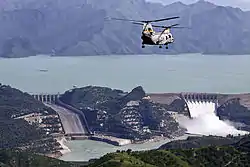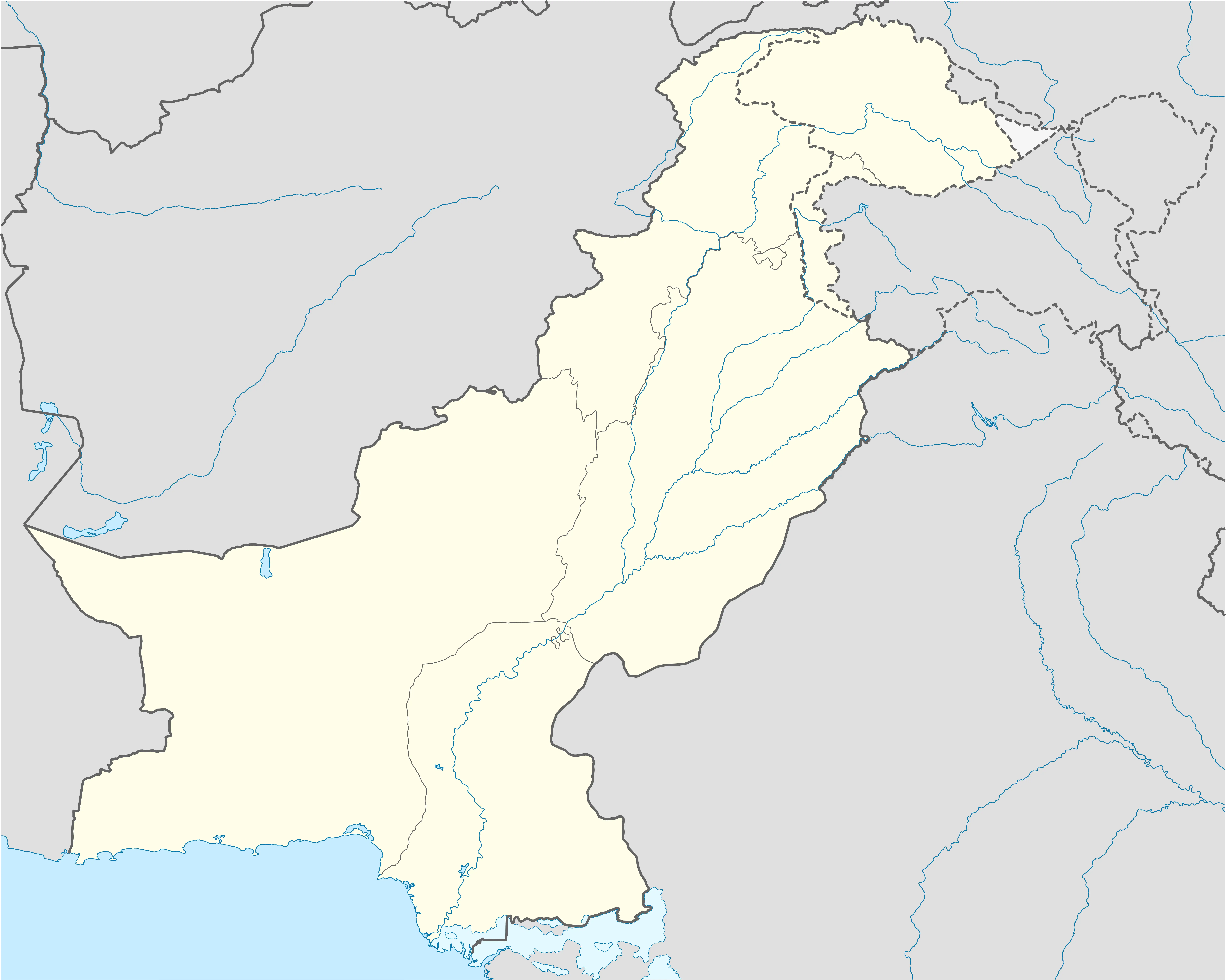Pakistan–United States military relations
Military relations between Pakistan and the United States have been present since the two established diplomatic relations in 1947. The United States and Pakistan's military have historically close ties and it was once called "America's most allied ally in Asia" by Nixon,[1] reflecting shared interests in security and stability in South Asia, Central Asia as well as in regions covering Eastern Europe at that time.[2]
.jpg.webp)
The military establishments of the two countries have cooperated to take action against militant groups involved in the wars in Afghanistan and Bosnia, although there is no consensus on issues such as dealing with the Taliban.[3] The Pakistan Army and Pakistan Air Force regularly engage in joint exercises with their American counter interservices, while the Pakistan Navy and the Pakistan Marines is the second most consistent participant in Combined Task Force 150 and Combined Task Force 151 after the United States Navy.[4]
Since 1956, the U.S. military personnel have served in the Pakistani military as military advisers and Pakistani military cadets have consistently attended the coveted U.S. military academies and war colleges.[5][6] Until the Trump administration prevented Pakistan’s access to the International Military Education and Training (IMET) plan. The plan later claimed to be restarted, but it has never been restored due to the COVID-19 epidemic and other reasons.[7] At the same time the United States canceled all military aid to Pakistan.[8] The current U.S. military relations with Pakistan has been replaced by the People's Liberation Army of China.[9][10]
The US Commerce Department's Bureau of Industry and Security (BIS) already added Pakistani companies on a US trade blacklist for their alleged involvement in missile and nuclear activities, making it difficult for these companies to do business internationally.[11]
U.S. bases
During the 20 years of War on terror, the following military bases in Pakistan have been accessible to the United States, mainly for logistics, relief efforts or as launching bases for drone operations.[12] Pakistan comes under the United States Central Command (USCENTCOM) theatre of operations.[13] The Afghanistan-Pakistan Center of Excellence is a division of USCENTCOM, focusing on analysis of operations in Pakistan and Afghanistan (formerly known as the AfPak theatre).[14] Currently, there are no U.S. bases in Pakistan.[15]
| Base | Location | Use |
|---|---|---|
| PAF Camp Badaber | Badaber, Peshawar, Khyber Pakhtunkhwa | Formerly known as the Peshawar Air Station, this was a former CIA and United States Air Force Security Service listening post, used by the 6937th Communications Group from July 17, 1959 until January 7, 1970 when it was closed. The base was used for intelligence gathering operations and radio transmission intercepts relating to the Soviet Union. At one point, there were 800 personnel and 500 supporting staff stationed at the base.[16] Francis Gary Powers, who was shot down and captured in the Soviet Union during the 1960 U-2 incident, took off from this base for his spy mission. |
| Shamsi Airfield | Washuk, Balochistan | A private airfield leased by the Abu Dhabi royal family for hunting trips to Pakistan. The UAE, under Pakistani government authorisation, sub-leased it to the Central Intelligence Agency and United States Air Force (USAF) on 20 October 2001.[17] The base was exclusively used to conduct drone operations in northwest Pakistan, and housed several U.S. military personnel. Blackwater employees were also involved in these operations.[18] The CIA and USAF jointly developed the airfield, constructing two permanent and one portable hangars for housing drones, in addition to support and residential facilities as well as resurfacing of the asphalt runway. The U.S. ceased its drone operations from Shamsi in April 2011, following the controversial Raymond Allen Davis incident. However, it continued using Shamsi airfield for logistics and emergency landings.[19] In November 2011, Pakistan ordered the eviction of U.S. personnel from the airbase in response to the Salala incident which heightened diplomatic tensions. Subsequently, the U.S. ceased its use of the base.[20] |
| PAF Base Shahbaz | Jacobabad, Sindh | Located in northern Sindh near the border with Balochistan, the U.S. military had exclusive use of the airbase since at least 2002 to coordinate operations in Afghanistan.[13] The base was also originally used for CIA drone operations in northwest Pakistan. According to sources, CIA drones were operated from this base "for some years". In 2001, around 250 U.S. Marines were stationed here for search-and-rescue operations.[21] As of 2010, around 50 American military personnel were stationed here in an inner cordon "US-only area" while the outer protective layer was under Pakistan Army control.[12] |
| Dalbandin Airport | Dalbandin, Balochistan | A public airport used by the U.S. since at least 2002 as a base to support Operation Enduring Freedom in Afghanistan.[13] The base was used to aid logistical support and intelligence operations in Afghanistan. It was also used as a refueling base for U.S. helicopters.[22] |
| Pasni Airport | Pasni, Balochistan | A commercial airport used by the U.S. since at least 2002 to support Operating Enduring Freedom in Afghanistan.[13] During early 2002, over a dozen U.S. military helicopters were stationed at Pasni. As of July 2006, the airport was still under the use of U.S. forces, with U-2 reconnaissance aircraft stationed here.[23] |
| PAF Base Nur Khan | Chaklala, Rawalpindi, Punjab | A base with permanent U.S. military presence, used for handling U.S. logistics and movements in relation to the war in Afghanistan. During the 2005 Kashmir earthquake, 300 American troops as well as U.S. aircraft were deployed here to aid in relief efforts.[12] |
| PAF Base Samungli | Quetta, Balochistan | Previously used for US military logistical operations in Afghanistan. The base did not feature a permanent presence, although the Pentagon is said to have been provided access to use the base "as and when".[12] |
| Tarbela Ghazi Airbase | Haripur, Khyber Pakhtunkhwa | A Pakistan Army Aviation Corps airbase. An anonymous source described the facility as a "big helipad".[12] During the 2010 Pakistan floods, U.S. CH-46 Sea Knight, CH-47 Chinook and UH-60 Black Hawk helicopters were stationed here for relief efforts.[24] |
| PAF Base Peshawar | Peshawar, Khyber Pakhtunkhwa | Occasionally used by U.S. forces as transit point while deploying to other locations.[12] |
Gallery
 A U.S. Marine Corps CH-46 Sea Knight helicopter en route from Tarbela Ghazi Airbase, providing flood relief efforts in 2010.
A U.S. Marine Corps CH-46 Sea Knight helicopter en route from Tarbela Ghazi Airbase, providing flood relief efforts in 2010. President George W. Bush meeting American troops posted at the U.S. embassy in Islamabad, during a state visit to Pakistan c. 2006.
President George W. Bush meeting American troops posted at the U.S. embassy in Islamabad, during a state visit to Pakistan c. 2006. The joint coordination of U.S.-Pakistani militaries to engage in flood relief efforts in Pakistan.
The joint coordination of U.S.-Pakistani militaries to engage in flood relief efforts in Pakistan.
References
- "PAKISTAN-US NEW CONNECTION: AN EVALUATION". Pakistan Institute of International Affairs. 1983.
- Khan, Mohammed Ayub (January 1964). "The Pakistan-American Alliance". Foreign Affairs. Archived from the original on 2016-10-10. Retrieved 17 July 2016.
- Bennett-Jones, Owen (2021-08-27). "Why Pakistan gambled on supporting the Taliban". The Telegraph. ISSN 0307-1235. Retrieved 2023-06-26.
- Iqbal, Anwar (11 March 2017). "Pakistan did 'helpful things' against Haqqanis: US general". Dawn. Archived from the original on 2017-04-12. Retrieved 12 April 2017.
- "Pakistani Air Force cadet departs for America to attend U.S. Air Force Academy". U.S. Embassy & Consulates in Pakistan. 16 June 2017. Retrieved 27 August 2020.
- "U.S. to resume military training program for Pakistan: State Department". Reuters. 20 December 2019. Retrieved 27 August 2020.
- Siddiqa, Ayesha (2023-04-04). "Pakistan has walked dangerously deep into Chinese grip. Wake up, West". ThePrint. Retrieved 2023-04-29.
- Akmal, Dawi (2022-03-16). "US-Pakistan Relations Ebb After Afghanistan Withdrawal". VOA. Retrieved 2023-05-17.
- "Foreign Military Relations of Pakistan". Pakistan Forces. Retrieved 1 April 2021.
- "A Threshold Alliance: The China-Pakistan Military Relationship". United States Institute of Peace. Retrieved 2023-03-23.
- Editorial (2023-03-05). "US blacklist". DAWN.COM. Retrieved 2023-03-05.
- Woods, Chris (15 December 2011). "CIA drones quit one Pakistan site – but US keeps access to other airbases". Bureau of Investigative Journalism. Archived from the original on 2016-08-26. Retrieved 17 July 2016.
- "Pasni and Jacobabad now in joint use of Pak, US air forces". The News. January 2002. Archived from the original on 29 January 2012. Retrieved 17 July 2016.
{{cite news}}: CS1 maint: bot: original URL status unknown (link) - Rajaee, B. (2011). National Security under the Obama Administration. Springer. p. 39. ISBN 9781137010476.
- "6 tough questions fielded by PM Abbasi in his maiden US visit". Dawn. 21 September 2017. Archived from the original on 2017-09-21. Retrieved 21 September 2017.
- Fulghum, Milton L. "Unit History". 6937th Communications Group, PAS, Peshawar, Pakistan. Archived from the original on 2016-04-19. Retrieved 17 July 2016.
- Khan, Air Marshal (Retd.) Ayaz Ahmed, "Shamsi Air Base", Defence Journal, November 2007, Volume 11, No. 4, Karachi, Pakistan
- Munawar, Harris Bin (9 December 2011). "What happens at Shamsi airfield?". The Friday Times. Archived from the original on 2012-01-26. Retrieved 17 July 2016.
- De Young, Karen (1 July 2011). "CIA idles drone flights from base in Pakistan". Washington Post. Archived from the original on 2016-08-22. Retrieved 17 July 2016.
- Henderson, Barney (11 December 2011). "US vacates airbase in Pakistan". The Telegraph. Archived from the original on 2016-05-29. Retrieved 17 July 2016.
- "Shahbaz Air Base". Global Security. 5 July 2011. Archived from the original on 2016-08-03. Retrieved 17 July 2016.
- "Dalbandin, Pakistan". Global Security. 5 July 2011. Archived from the original on 2016-08-03. Retrieved 17 July 2016.
- "Pasni, Pakistan". Global Security. 5 July 2011. Archived from the original on 2016-08-03. Retrieved 17 July 2016.
- "Soldiers, helicopters to deploy for Pakistan relief". United States Army. 31 August 2010. Archived from the original on 2017-02-05. Retrieved 17 July 2016.
